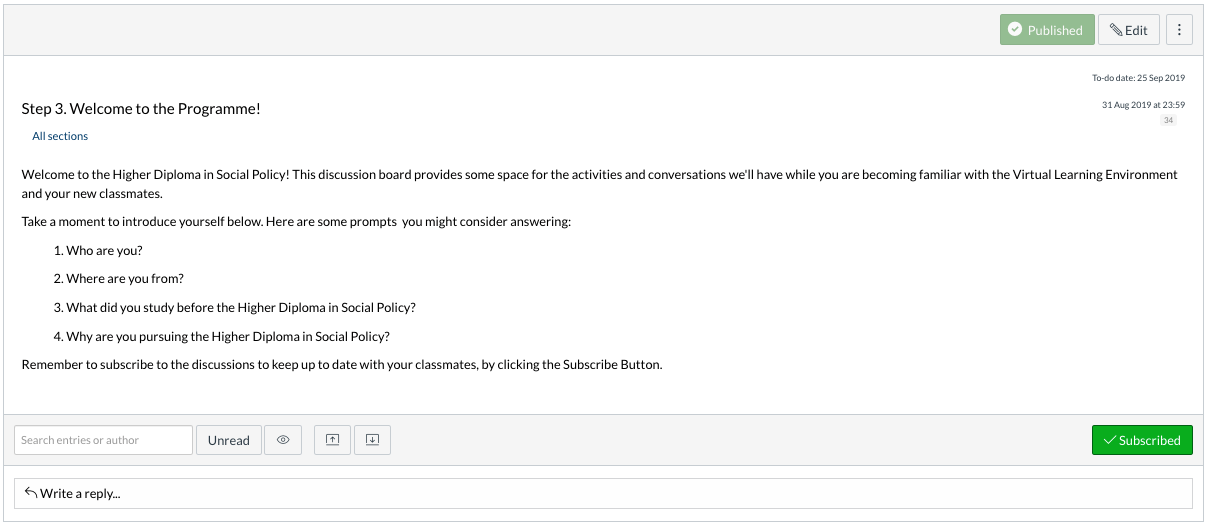- CIRTL Homepage
- Meet our Team
- Resources
- Short Guides
- Short Guide 1: Starting Well
- Short Guide 2: Scaffolding Learning
- Short Guide 3: Icebreakers
- Short Guide 5: Discussions for Online Learning
- Short Guide 4: Visualising Thinking
- Short Guide 6: Universal Design for Learning
- Short Guide 7: Group Work
- Short Guide 8: Reimagining Practicals
- Short Guide 9: Assessment in the Age of AI
- Universal Design for Learning
- CIRTL Series
- Sustainable Development Goals Toolkit
- Learning Design Workshops
- Connected Curriculum
- Group Work
- Civic Engagement Toolkit
- Learning Outcomes
- DigiEd Reading List
- Ethical Use of GenAI Toolkit
- Short Guides
- Professional Development
- Postgraduate Certificate in Teaching and Learning
- Diploma in Teaching and Learning in Higher Education
- MA in Teaching and Learning in Higher Education
- International Scholars
- Postgraduate Modules in Teaching and Learning
- Digital Badges
- Postgraduate Certificate in Professional Practice and Leadership
- CPD Certificate in Digital Education
- Research your Teaching
- Projects
- Events
- Office of the Vice President for Learning & Teaching
Short Guide 3: Icebreakers
Explore this page
1. Getting to know you
One challenge of teaching in Higher Education is to create a sense of community. This is already difficult in large classes or in classes with a mix of students from different programmes, but can become even more pronounced in online learning.
Establishing a welcoming online environment allows students to settle into module and adjust to online or blended modes of learning. This can include a walk-through video of the module on Canvas and a welcome video from the module coordinator, or a live orientation session on MS Teams or Google Meet.
Incorporating icebreaker activities into the first week of a module can help establish a positive tone, help you become acquainted with your students and the students with each other, and lay the groundwork for an interactive and collaborative learning experience.
2. Breaking the ice
However, all icebreakers are not created equal. Almost all require students to publicly share some type of personal information with people they have only just met, which can feel high risk. Others can be so impersonal as to be meaningless. The better ones set the stage for future course activities and can serve a double function of encouraging students to trial the use of a digital tool or mode of engagement as a low-stakes activity.
As you plan your icebreaker, think about the goal you are trying to achieve. In all examples you should first introduce the activity and explain why you are using it. If it is a live class then you could provide your own response as an example.
| The What | The How |
|---|---|
| Learn about each other (for large cohorts or first year classes) |
Break students into groups (on Canvas or via channels on MS Teams). Ask them to identify and list all the things they have in common and name one thing unique to each student in the group. These responses can be anonymised if that makes students more comfortable. Ask them to post on Canvas discussion board or shared Google Document. |
| Learn about each other (for smaller cohorts or groups who already are familiar with the University/each other) |
Share photo of object, place, or person that is important or meaningful to them on a Canvas discussion board or shared Google document or JamBoard and include description as to how this might relate to why they are taking the course.
Write a 6-word story about themselves on Canvas discussion board or shared Google document. |
| Learn about your students | Create a short questionnaire for your students on Google Forms. This could include questions about their broadband speed, their access to a digital device to aide their learning, as well as more general questions such as favourite song, hobbies, first job etc. Interspersing these insights, if appropriate, during the course may help the student feel a greater sense of being ‘seen’ in the class and foster engagement. |
| Familiarise students with a digital tool (and each other) | JamBoard is a useful tool for collaborative learning and, as an online interactive whiteboard, can support more creative forms of student engagement. One example is asking students to share an image relating to somewhere they have had an adventure. First draw the 4 compass points, North South East West (NSEW), on the Google JamBoard and ask students to post an image in the appropriate area. This can happen synchronously or asynchronously. They not only have to choose what adventure to share, but also must decide where to place their image on the NSEW axes. This activity works best for smaller groups as the Google JamBoard gets quite cluttered, or you can break the students into smaller groups and share a few different boards. |
| Assess course-related knowledge and skills (see Angelo and Cross) | Ask students to complete a short questionnaire (on Google Forms or similar) at the beginning of a course or at the start of a new topic. This can serve as a pre-test of student’s knowledge and skill which can inform your teaching. Icebreakers can also take the form of a misconception/ preconception test, where the focus is on uncovering prior knowledge or beliefs that potentially might hinder or block new learning. |
3. Preparing for September
This section includes reflections from staff across the University on what worked well in the past and what they are planning in their future teaching:
I use icebreakers in all of my teaching and translating these ice-breakers to an online environment was one of the challenges I faced when I became the Director of the Higher Diploma in Social Policy (online). For me, it was critical that the icebreaker introduced the students not only to each other, but also to Canvas and the tools they would be required to use over the course of their studies. It was for this reason that I used the discussion board feature on Canvas to introduce the icebreaker.
The icebreaker was integrated into a five step Programme Orientation that introduced students to me, the module content, Canvas, and the online library resources. For the icebreaker, I devised a series of short prompts (pictured) to encourage the students to participate. These four prompts also structured the participation for students who were new to the platform and online learning. While this was a very simple exercise, the students reported that it had a positive impact on their experiences of building relationships within the class and with me. It was clear at this early point that there were shared interests in the group, and together they shaped the tone of the class discussions moving forward. Cultivating and fostering relationships are equally as important in online learning environments, but it doesn’t have to be complicated. Sometimes, it’s as simple as “Hello, I’m Becci. What’s your name?
Becci Jeffers, Applied Social Studies

Further Resources
Angelo, T.A. and Cross, K.P. (1993) 50 Classroom Assessment Techniques. Available at:https://vcsa.ucsd.edu/_files/assessment/resources/50_cats.pdf
Chlup, D. and Collins, T. (2010) Breaking the Ice: Using Ice-breakers and Re-energizers with Adult Learners. Adult Learning, 21, 3/4, pp. 34-39.
Cornell University (2020) “Building Inclusive Classrooms: Icebreakers” Center for Teaching Innovation. Available at:https://teaching.cornell.edu/teaching-resources/building-inclusive-classrooms/icebreakers
Mansbrach, J. (2015) “The importance of icebreakers in online classes”. Northwestern University School of Professional Studies. July 28, 2015. Available at: https://dl.sps.northwestern.edu/blog/2015/07/the-importance-of-icebreakers-in-online-classes/
Training and Support
Getting Started webpage
This webpage introduces both academic and professional staff to the first steps in preparing to teach (and support teaching) remotely in September. Guidance is provided on how to teach remotely, the importance of Canvas, what tools to use and when, and signposting you to the relevant training and resources available in this regard.
Teach Digi Summer Training
Learn from academic and instructional designer Dr. Sarah Thelen as he delivers weekly asynchronous recordings structured around Think, Plan, and Teach and supported by Live Q&As. A great entry point for those who have their curriculum and learning activities already prepared.
Canvas training
Do you want to learn how to use UCC's virtual learning environment more effectively? Look no further. Sophie Gahan of the CDE is delivering weekly Canvas training over the summer.
CIRTL Learning Design workshops
Are you thinking about how you will teach in September, January, and beyond? The Learning Design workshop guides you through some collaborative structured exercises to provide a robust framework for curriculum and learning design. Patrick Kiely of CIRTL will host these workshops throughout the summer.
AVMS Guide to online video and collaboration
Panopto is not just about lecture capture you know? MS Teams is not just for meetings. Get oriented to the full capability of the UCC's video tools. A great starting point before pressing the record button!
ITS Teaching and Working remotely (tools)
Microsoft Office 365, Google Suite for Education, and everything else. A great resource for those who want to review and learn about all of the tools we have available in UCC.
UCC Skills Centre
Supporting students through the closure and now a comprehensive resource for September and beyond. See where you can direct your students to help them reach their potential.

